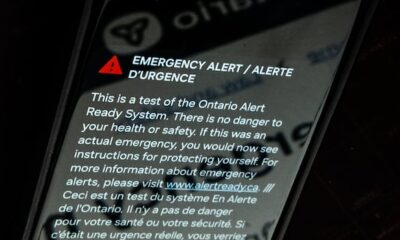Top Stories
Urgent Study Reveals Microplastics in 100% of Nova Scotia Lobsters

BREAKING: A shocking new study from Dalhousie University reveals that 100% of the lobsters tested off the coast of Nova Scotia contain microplastics, raising alarming concerns for seafood lovers and environmentalists alike. This urgent discovery suggests that plastic pollution is far more pervasive in our food supply than previously thought.
Researchers, led by Amber LeBlanc, found an average of six to seven microplastic particles per gram of lobster meat. “With every bite of seafood, you’re ingesting microplastics,” LeBlanc stated, highlighting the immediate health implications of this contamination.
The study involved purchasing 16 lobsters from local retailers, mimicking the consumer experience of buying, cooking, and eating these shellfish. Each sample revealed contamination, with microplastics including fibers from polyester clothing and polyethylene vinyl acetate (PVA), commonly found in household products like laundry pods. LeBlanc emphasized the misconception that “biodegradable” products are environmentally friendly, stating, “Studies are finding that it does leave behind microplastics.”
The findings are particularly significant as lobsters serve as bioindicators, revealing critical data about environmental health. The study demonstrated that microplastics can accumulate in various anatomical regions of lobsters, amplifying contamination levels in organisms that consume them. Previous research has primarily focused on European species, but this study sheds light on the American lobster, the dominant species in the global industry.
LeBlanc remarked on the escalating plastic crisis, noting that since the 1950s, plastic production has skyrocketed, with no signs of slowing down. “Microplastics are everywhere,” she warned. In a related study, it was reported that the average American adult ingests between 126 and 142 microplastic particles daily, while inhaling an additional 132 to 170 particles.
The implications of these findings extend beyond seafood. Microplastics have been linked to potential health risks, including cardiovascular disease, diabetes, premature births, and cancer. LeBlanc stressed the urgency of addressing plastic waste and fostering sustainable fishing practices, stating, “The plastic pollution crisis isn’t removed from us. It’s also ending up on our dinner plates.”
As the public grapples with these alarming revelations, immediate action is necessary. Authorities and environmental groups are called to reassess regulations surrounding plastic production and seafood safety. The health of our oceans and the safety of our food supply depend on urgent reforms.
Stay tuned for more developments on this critical issue as researchers continue to explore the far-reaching effects of microplastics on human health and the environment.
-

 World4 months ago
World4 months agoScientists Unearth Ancient Antarctic Ice to Unlock Climate Secrets
-

 Entertainment4 months ago
Entertainment4 months agoTrump and McCormick to Announce $70 Billion Energy Investments
-

 Lifestyle4 months ago
Lifestyle4 months agoTransLink Launches Food Truck Program to Boost Revenue in Vancouver
-

 Science4 months ago
Science4 months agoFour Astronauts Return to Earth After International Space Station Mission
-

 Technology2 months ago
Technology2 months agoApple Notes Enhances Functionality with Markdown Support in macOS 26
-

 Top Stories4 weeks ago
Top Stories4 weeks agoUrgent Update: Fatal Crash on Highway 99 Claims Life of Pitt Meadows Man
-

 Sports4 months ago
Sports4 months agoSearch Underway for Missing Hunter Amid Hokkaido Bear Emergency
-

 Politics3 months ago
Politics3 months agoUkrainian Tennis Star Elina Svitolina Faces Death Threats Online
-

 Politics4 months ago
Politics4 months agoCarney Engages First Nations Leaders at Development Law Summit
-

 Technology4 months ago
Technology4 months agoFrosthaven Launches Early Access on July 31, 2025
-

 Top Stories2 weeks ago
Top Stories2 weeks agoFamily Remembers Beverley Rowbotham 25 Years After Murder
-

 Top Stories6 days ago
Top Stories6 days agoBlake Snell’s Frustration Ignites Toronto Blue Jays Fan Fury





















